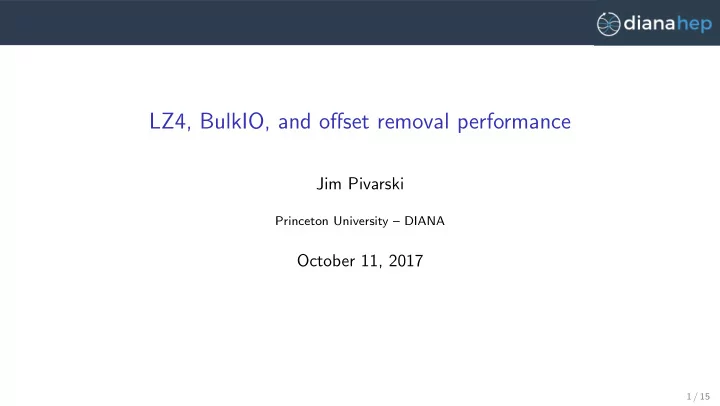

LZ4, BulkIO, and offset removal performance Jim Pivarski Princeton University – DIANA October 11, 2017 1 / 15
Motivation for this study Three updates to ROOT I/O are aimed at speeding up or reducing file size for end-user analysis: ◮ new compression algorithm: LZ4 (speed) ◮ reading TBasket data directly into arrays: BulkIO (speed) ◮ removing offset data from TBranches that have a counter (size) 2 / 15
Motivation for this study Three updates to ROOT I/O are aimed at speeding up or reducing file size for end-user analysis: ◮ new compression algorithm: LZ4 (speed) ◮ reading TBasket data directly into arrays: BulkIO (speed) ◮ removing offset data from TBranches that have a counter (size) Focus on CMS NanoAOD in particular because ◮ it is aimed at end-users (1–2 kB/event) ◮ it is broadly intended for 30–50% of analyses (not an individual user’s ntuple) 2 / 15
Motivation for this study Three updates to ROOT I/O are aimed at speeding up or reducing file size for end-user analysis: ◮ new compression algorithm: LZ4 (speed) ◮ reading TBasket data directly into arrays: BulkIO (speed) ◮ removing offset data from TBranches that have a counter (size) Focus on CMS NanoAOD in particular because ◮ it is aimed at end-users (1–2 kB/event) ◮ it is broadly intended for 30–50% of analyses (not an individual user’s ntuple) Also including studies of LHCb (thanks, Oksana!). No ATLAS files because I can’t generate new ones or TTree::CopyTree old ones. 2 / 15
Parameters of the NanoAOD studies ◮ AWS instance with a fast SSD disk (i2.xlarge). ◮ No resource contention because I paid for exclusive access. ◮ “Writing” means a TTree::CopyTree with new TFile compression. ◮ “Reading” means filling a class made by MakeClass. ◮ “BulkIO” means filling arrays through GetEntriesSerialized . ◮ Always reading from warmed cache. ◮ Five repeated trials; standard deviations are small compared to trends. 3 / 15
LZ4 doesn’t compress as well as ZLIB, LZMA 4 / 15
. . . same for LHCb 5 / 15
But it’s faster: levels 1–3 are as fast as writing uncompressed 6 / 15
. . . same for LHCb 7 / 15
More importantly: reading is as fast as uncompressed 8 / 15
And BulkIO reading is super-fast: serious penalty for LZMA 9 / 15
Speed vs. size trade-offs write speed vs size read speed vs size BulkIO speed vs size 10 / 15
Removing unnecessary offsets TBranches for variable-sized data contain offsets indicating where each entry starts. ◮ This is unnecessary for branches with counters (e.g. "Muon.pt[nMuons]/F" ). ◮ A fix is in progress (PR #1003) to optionally not write these offsets. ◮ May also write counts, instead of offsets, since repeated values might be more compressible. My study pre-dated (inspired) this PR; I constructed a copy of NanoAOD without offsets by putting all muon data into a flat TTree, all jet data into a flat TTree, etc. 11 / 15
After compression, this saves 8–18% 12 / 15
And it closes the LZ4/LZMA gap to a factor of 1.5 × 13 / 15
And it closes the LZ4/LZMA gap to a factor of 1.5 × 13 / 15
Do offsets vs. counts matter? Yes for LZ4. Synthetic test: I generated Poisson-random counts and integrated them to make offsets, then ZLIB and LZ4 compressed them. 14 / 15
Conclusions LZ4 is as fast as uncompressed data for traditional GetEntry jobs. BulkIO is an order of magnitude faster than GetEntry , especially with LZ4. Unnecessary offsets add ∼ 10% to file size; may be removed. Counts compress better than offsets, especially for LZ4. 15 / 15
Recommend
More recommend